How Rocks Form
Igneous Rocks
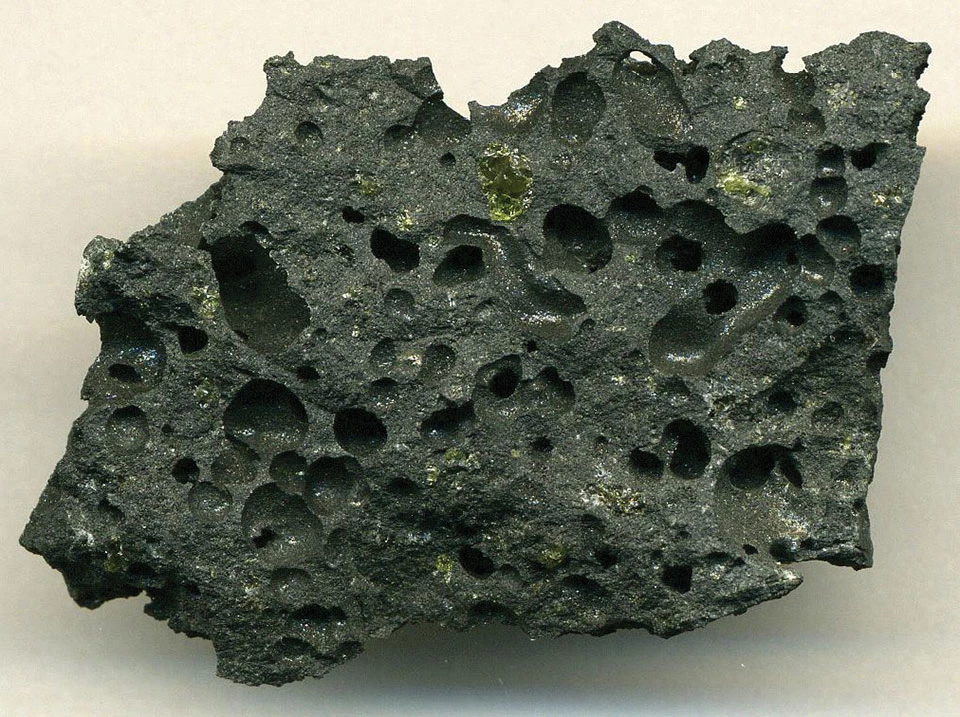
Vesicular basalt with olivine phenocrysts, illustrating rapid cooling of lava at the surface and gas bubble formation
Igneous rocks form when molten material (magma or lava) cools and solidifies. This process creates distinctive crystalline structures that reveal how long the cooling took.
- Intrusive igneous rocks (like granite) form when magma cools slowly deep underground, creating large, visible crystals.
- Extrusive igneous rocks (like basalt) form when lava cools quickly at the surface, creating tiny crystals or glass.
The Time Problem
- Granite batholiths are massive underground rock bodies that can be hundreds of miles across. Laboratory experiments show granite needs at least 1,000 years to cool completely, and large batholiths require 100,000 to millions of years. The Sierra Nevada batholith in California would need over 10 million years to cool and solidify completely.
- Layered intrusions show multiple separate injection events with cooling periods between each layer. Some complexes have dozens of distinct layers, each requiring separate cooling time.
- Contact metamorphism zones around intrusions show heat gradually affecting surrounding rocks over distances of several miles - a process requiring extensive time for heat conduction through solid rock.
Sedimentary Rocks
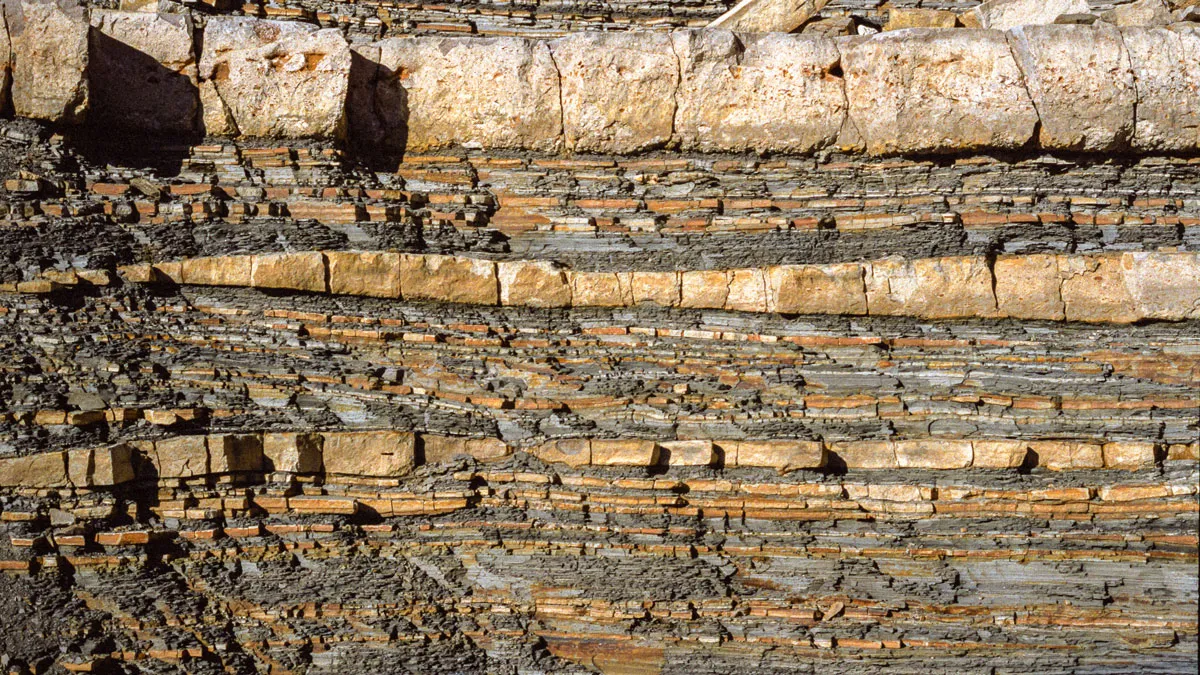
Clearly defined sedimentary rock layers showing different depositional environments over time
Sedimentary rocks form when particles settle in layers, get buried, and slowly turn to stone through compression and mineral cement.
- Clastic: Made from rock fragments transported by water, wind, or ice (sandstone, shale)
- Chemical: Formed from minerals that slowly precipitate from water (limestone, salt deposits)
- Organic: Made from accumulated plant or animal remains (coal, some limestones)
The Time Problem
- Coal formation: Coal beds up to 100 feet thick represent millions of years of plant accumulation. Modern peat bogs (the first stage of coal) grow only 1-2 feet per thousand years. The coal layers would require at least 50-100 million years to accumulate.
- Limestone reefs: Ancient coral reefs in limestone show individual coral colonies that grew in place for hundreds of years, with multiple reef systems stacked on top of each other representing millions of years of growth.
- Evaporite deposits: Salt and gypsum beds hundreds of feet thick require repeated cycles of seawater evaporation. Laboratory calculations show the thickest deposits need millions of evaporation cycles.
- Mature soil layers (paleosols): Fossil soils between rock layers show roots, soil horizons, and mineral alterations that take thousands of years to develop under normal conditions.
Metamorphic Rocks
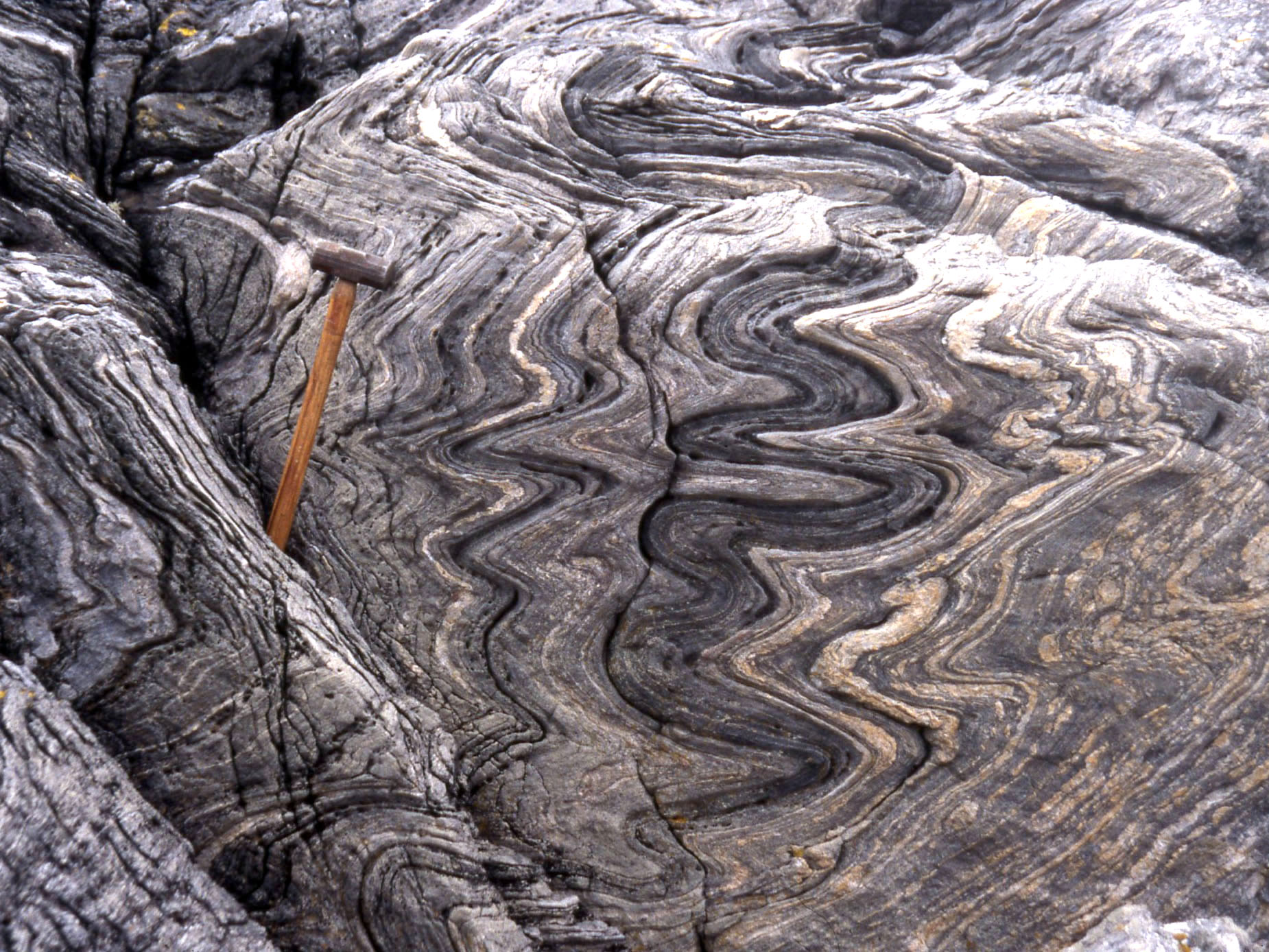
Folded Amphibolite Gneiss. Near Trondheim, Norway
Metamorphic rocks form when existing rocks are changed by heat and pressure deep in the Earth's crust, creating entirely new mineral combinations.
- Regional metamorphism: Changes rocks across vast areas during mountain building
- Contact metamorphism: Changes rocks near hot magma intrusions
The Time Problem
- Progressive metamorphism: Some rocks show multiple stages of mineral changes, each requiring different temperatures and pressures over time. This indicates burial, heating, cooling, and re-heating cycles spanning millions of years.
- Metamorphic core complexes: These show rocks that were buried 20+ miles deep, heated, then slowly uplifted and exposed. The cooling rates preserved in mineral compositions indicate millions of years for this cycle.
- Pressure release textures: Some metamorphic minerals show they formed under extreme pressure, then slowly decompressed as overlying rock eroded away - a process requiring millions of years.
Stratigraphy
Stratigraphy studies rock layers and their relationships. Several fundamental principles help us understand the sequence of geological events.
- Law of Original Horizontality: Sediment layers are deposited horizontally. Tilted or folded layers were moved after formation.
- Law of Superposition: In undisturbed sequences, older layers are on the bottom, younger layers on top.
- Law of Lateral Continuity: Sediment layers originally extended in all directions until they thinned out or hit barriers.
- Law of Cross-Cutting Relationships: Any feature that cuts across existing layers (faults, intrusions) is younger than what it cuts.
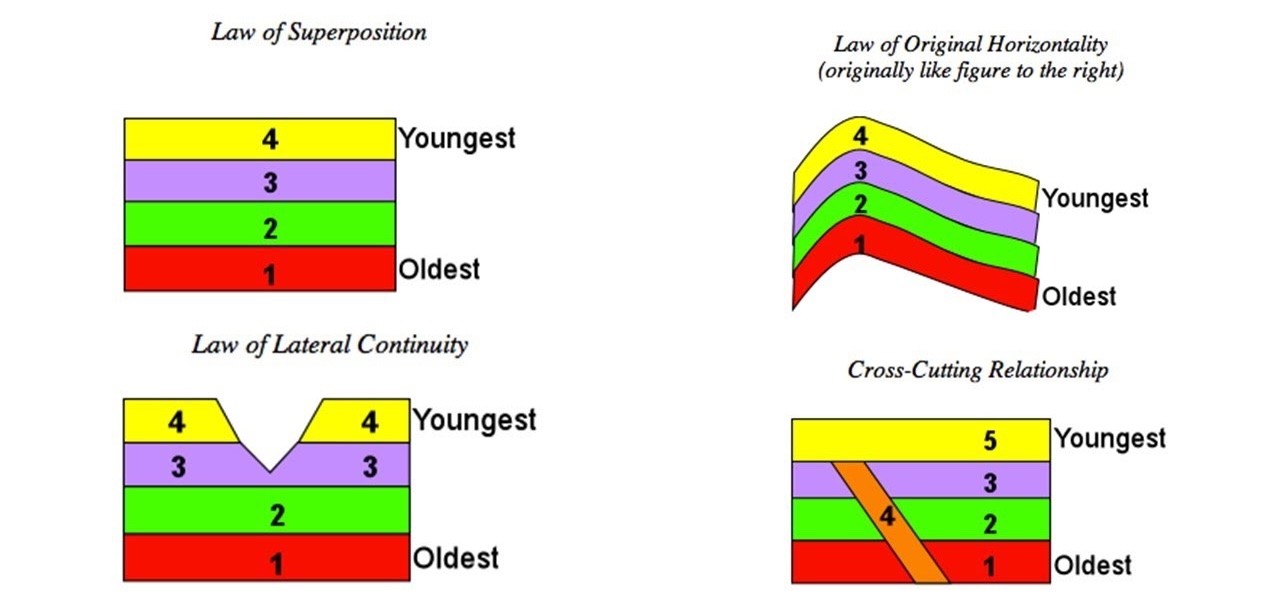
Stratified rock layers illustrating the principles of stratigraphy
Global Consistency
- Worldwide correlation: The same sequence of rock layers and fossils appears on every continent. For example, Cambrian trilobites are found below Devonian fish fossils everywhere on Earth.
- No exceptions: Despite searching for over 150 years, geologists have never found human fossils mixed with dinosaurs, or flowering plants in Precambrian rocks, or any violations of the consistent fossil sequence.
- Angular unconformities: These show older tilted layers that were eroded flat, then covered by new horizontal layers - requiring separate time periods for deposition, tilting, erosion, and new deposition.
Deep Time
Geology reveals "deep time" - Earth's 4.6-billion-year history that dwarfs human experience. Multiple independent lines of evidence converge on these vast timescales.
Earth's 4.6 Billion Year History
Relative proportions of major geological eras
The tiny red slice represents all of human history—barely visible compared to Earth's immense geological timeline.
Time Evidence from Multiple Sources
- Ice core layers: Annual layers in ice cores extend back 800,000+ years, with each layer representing one year's snowfall.
- Tree ring sequences: Overlapping tree ring patterns extend back over 12,000 years in continuous sequences.
- Varve deposits: Annual lake sediment layers (varves) in some locations show millions of individual years preserved in the rock record.
- Light travel time: We observe galaxies billions of light-years away, meaning their light has been traveling toward us for billions of years.
Depositional Environments
Rock formations preserve detailed records of the environments where they formed. These features allow precise reconstruction of ancient conditions that are incompatible with a single global flood.
Desert Formations
Ancient desert environments leave unmistakable signatures:
- Cross-bedded sandstones showing preserved sand dunes:
- Evaporite minerals from repeated lake drying cycles:
- Wind-polished ventifacts:

Ventifacts in the Sahara Desert
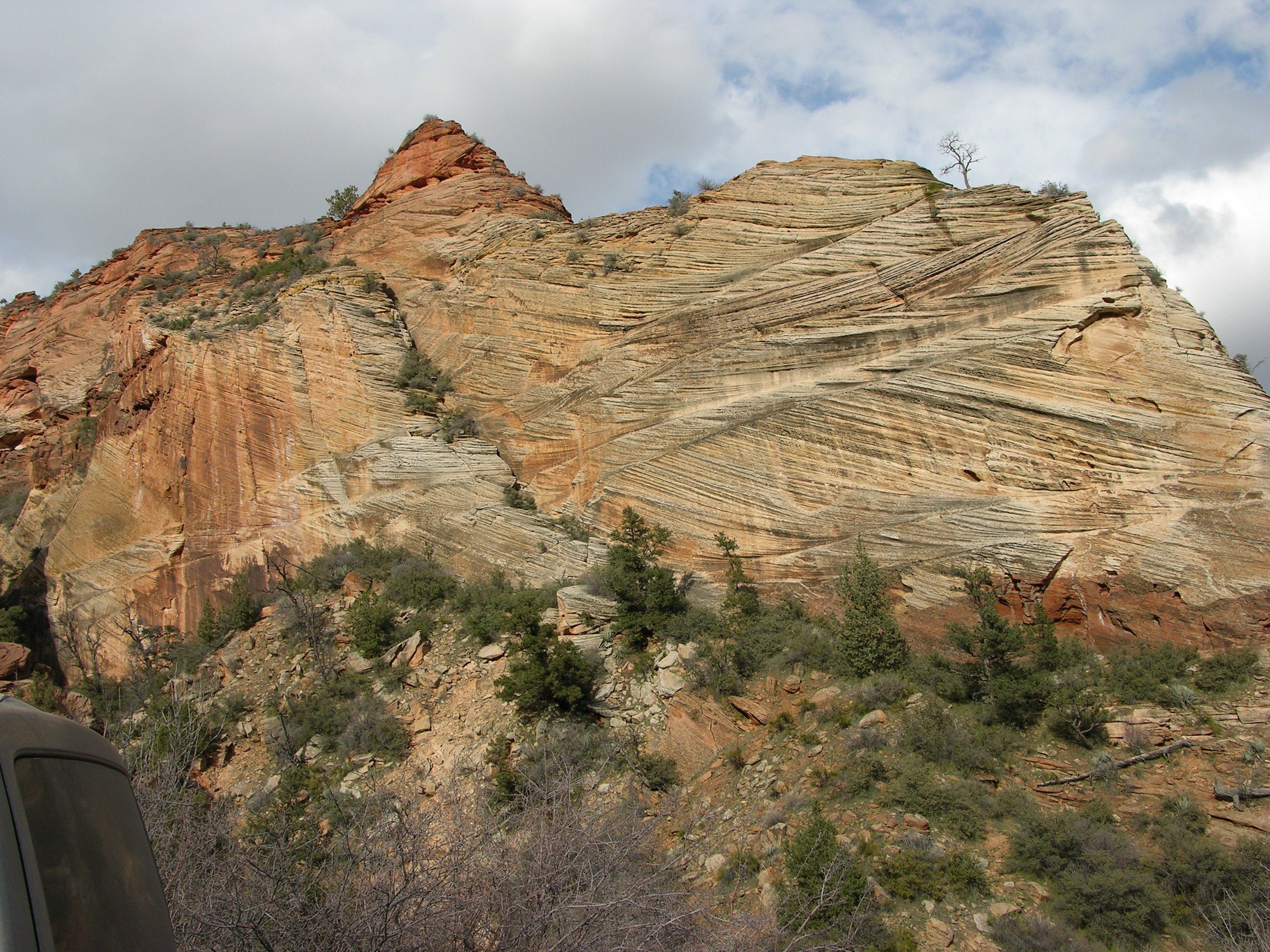
Cross-bedding of sandstone near Mt. Carmel road, Zion Canyon
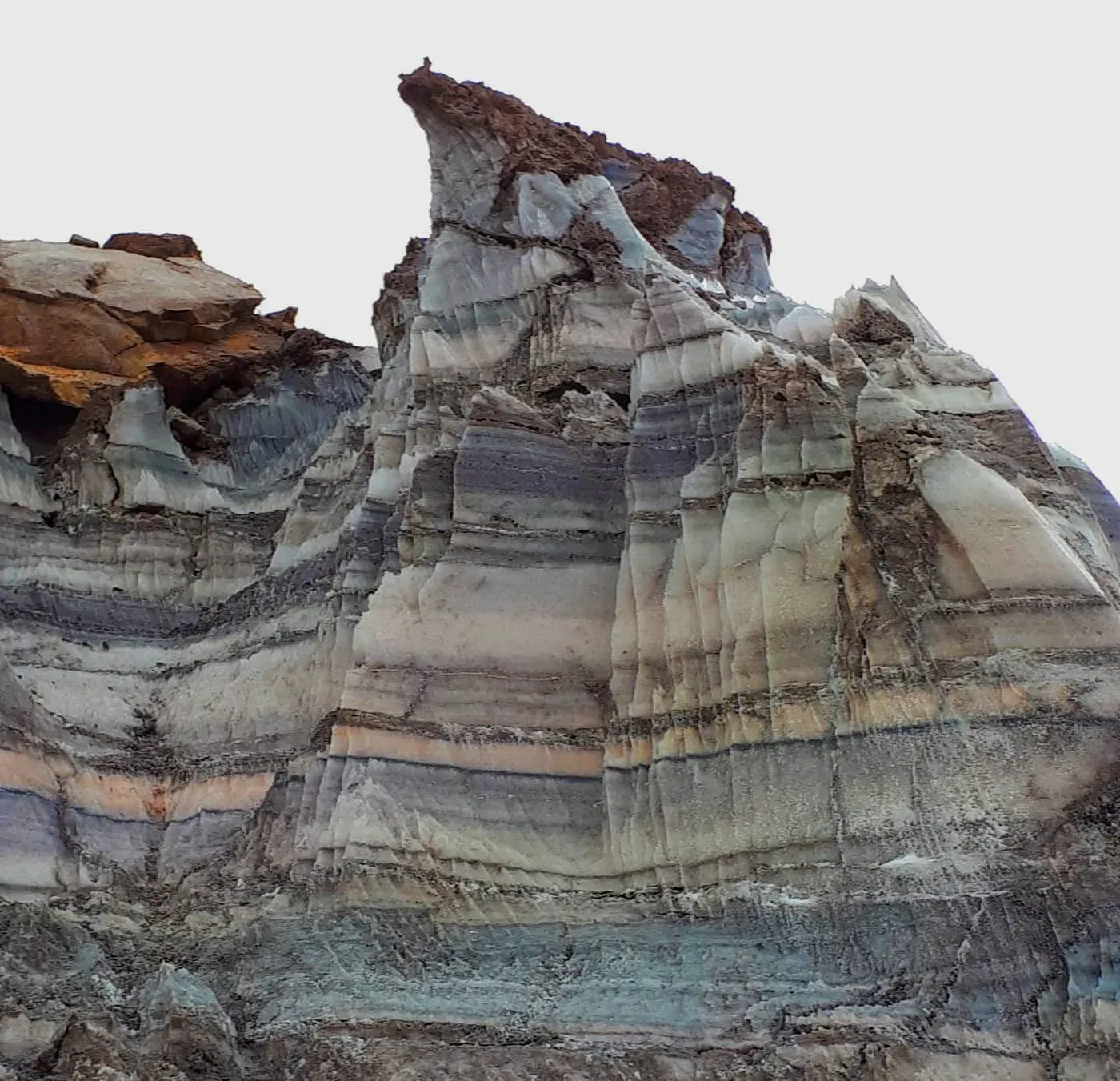
Evaporites in Zagros, Iran
Glacial Deposits
Ice ages leave distinctive evidence requiring long-term climate cycles:
- Unsorted glacial till with distinctive dropstones:
- Striated and polished bedrock:
- Dropstones in fine marine sediments:
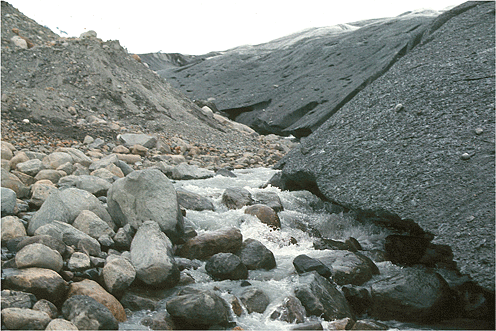
Glacial till at Glacier Bay National Park, Alaska

Glacially polished and striated bedrock, Yosemite National Park.
Photo: Eric in SF, CC BY-SA 3.0
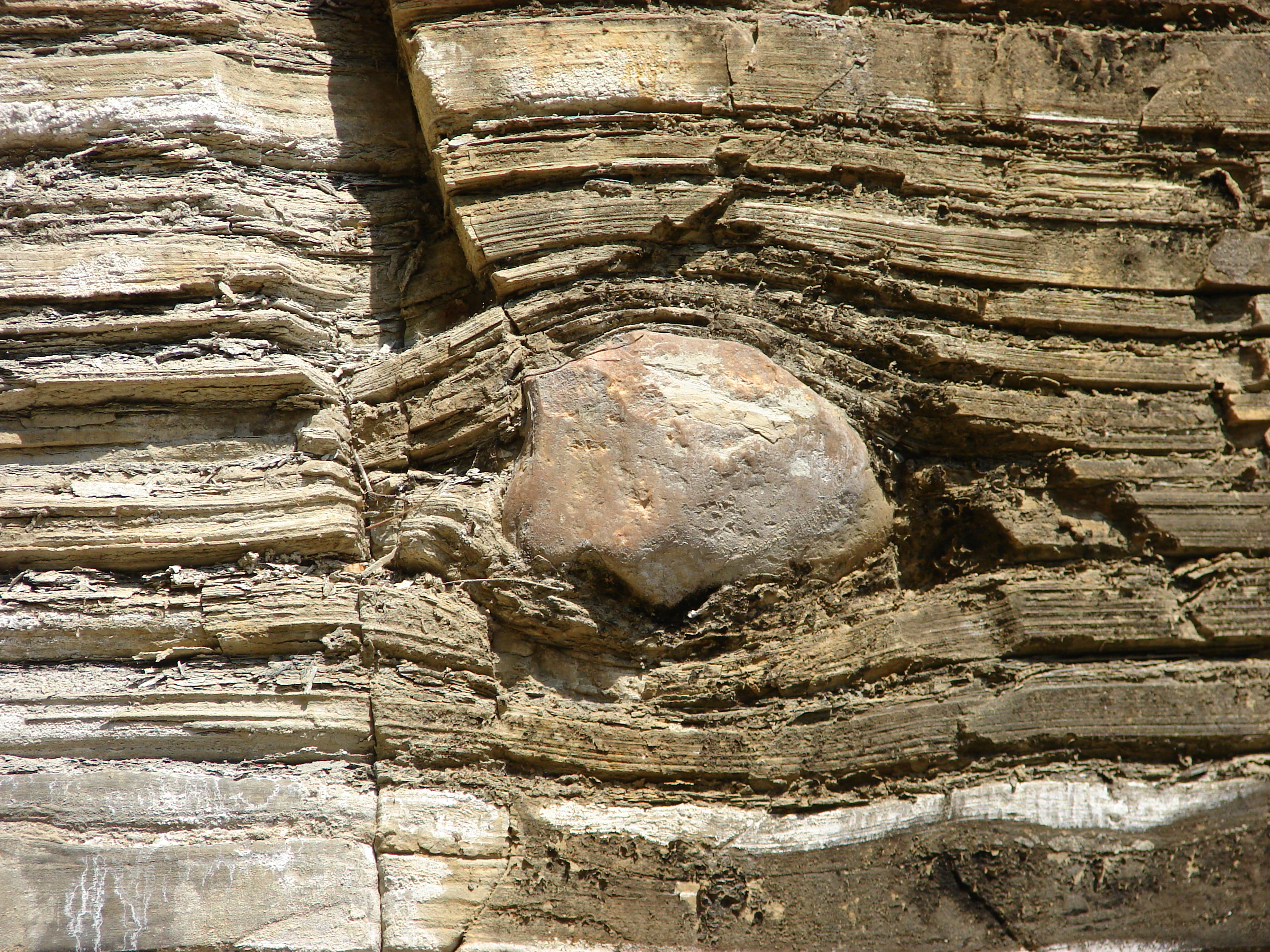
Dropstone in glaciomarine sediment.
Photo: Eurico Zimbres, CC BY-SA 2.5
Shallow Marine Environments
Coastal environments preserve evidence of gradual deposition:
-
Ripple marks from wave action:
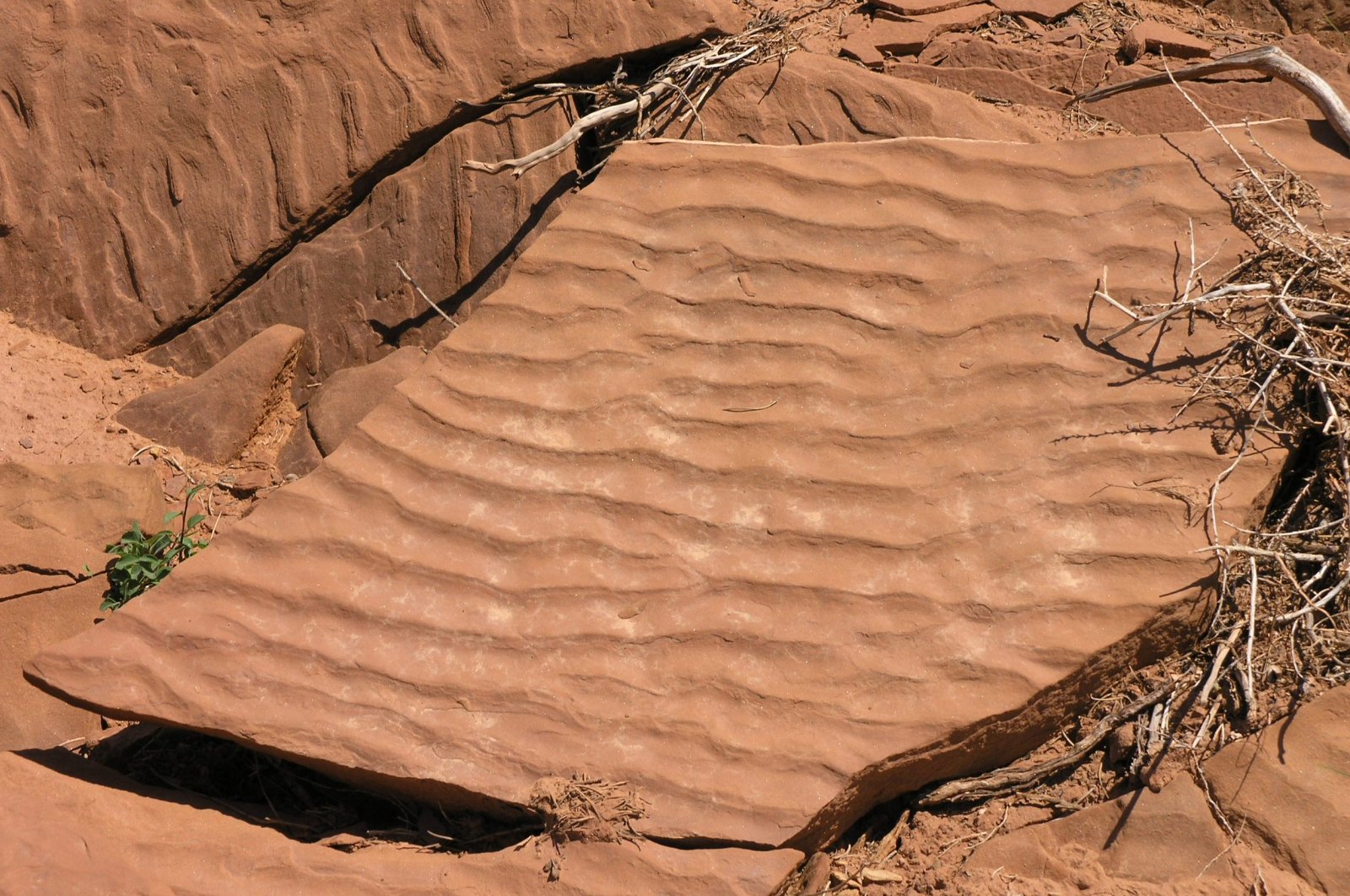
Ripple marks in the Moenkopi Fm., Capitol Reef National Park (Utah).
Photo: © Daniel Mayer/Wikimedia.commons -
Mud cracks from periodic drying:
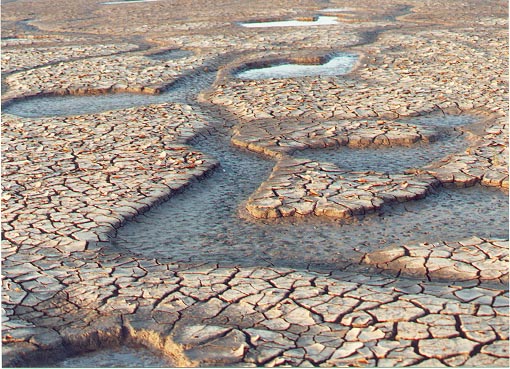
Mudcracks on the shore of The Wash, England. Photo: Alan Parkinson, CC BY-SA 2.0
-
Intact fossil communities of shallow-water organisms:
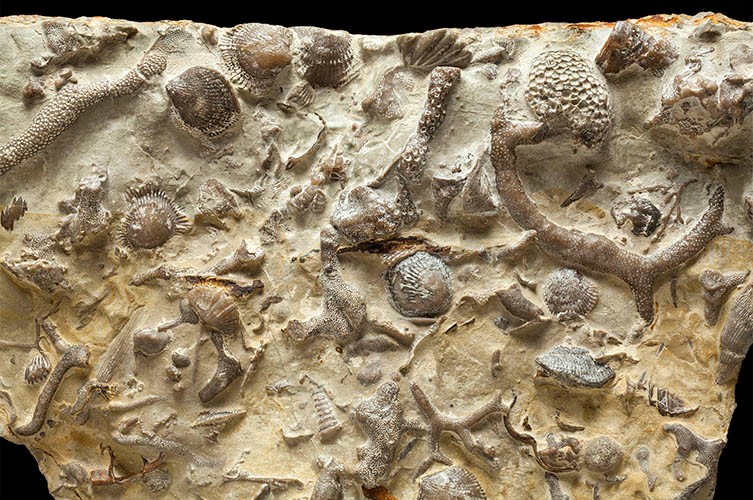
A fossilised section of sea floor dating back 430 million years.
Credit: The Natural History Museum, London
Incompatible with a Single Flood
- Desert dunes: Cross-bedded sandstones show wind-blown sand dunes that formed in dry conditions over thousands of years. These delicate structures would be destroyed by flood water.
- Seasonal layers: Many formations show annual cycles of wet and dry seasons, with thousands of these cycles preserved in sequence.
- In-place fossil forests: Petrified forests with intact root systems show trees that grew in place for centuries, died, were buried, then new forests grew on top - repeated many times in vertical succession.
- Intact burrows: Vertical animal burrows extend through multiple rock layers, showing slow, gradual burial rather than catastrophic flooding.
- Coral reefs: Massive limestone reefs show corals that grew in place over thousands of years, with multiple reef systems stacked vertically.
Tectonic Processes
Plate tectonics explains Earth's surface features through slow-moving crustal plates. The evidence requires millions of years of gradual movement.
Key evidence includes:
- Matching continental margins and geology across oceans:
-
Mountain ranges that continue across separated continents:
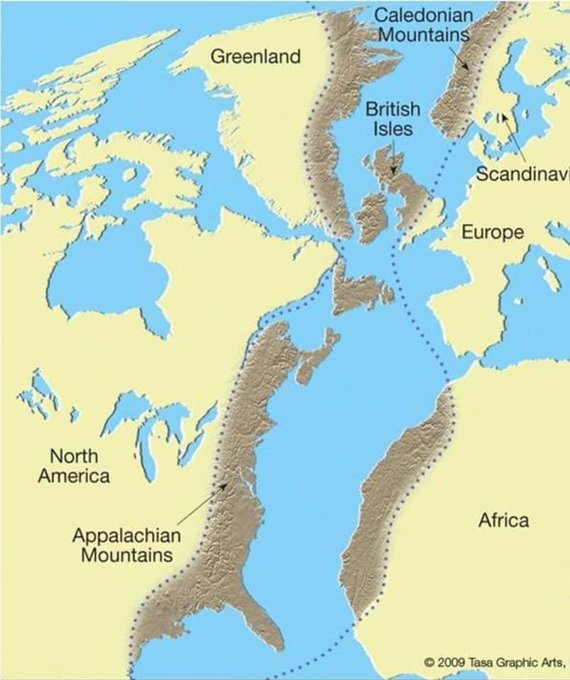
Example of mountain range separated by continental drift
-
Earthquake and volcanic patterns following plate boundaries:
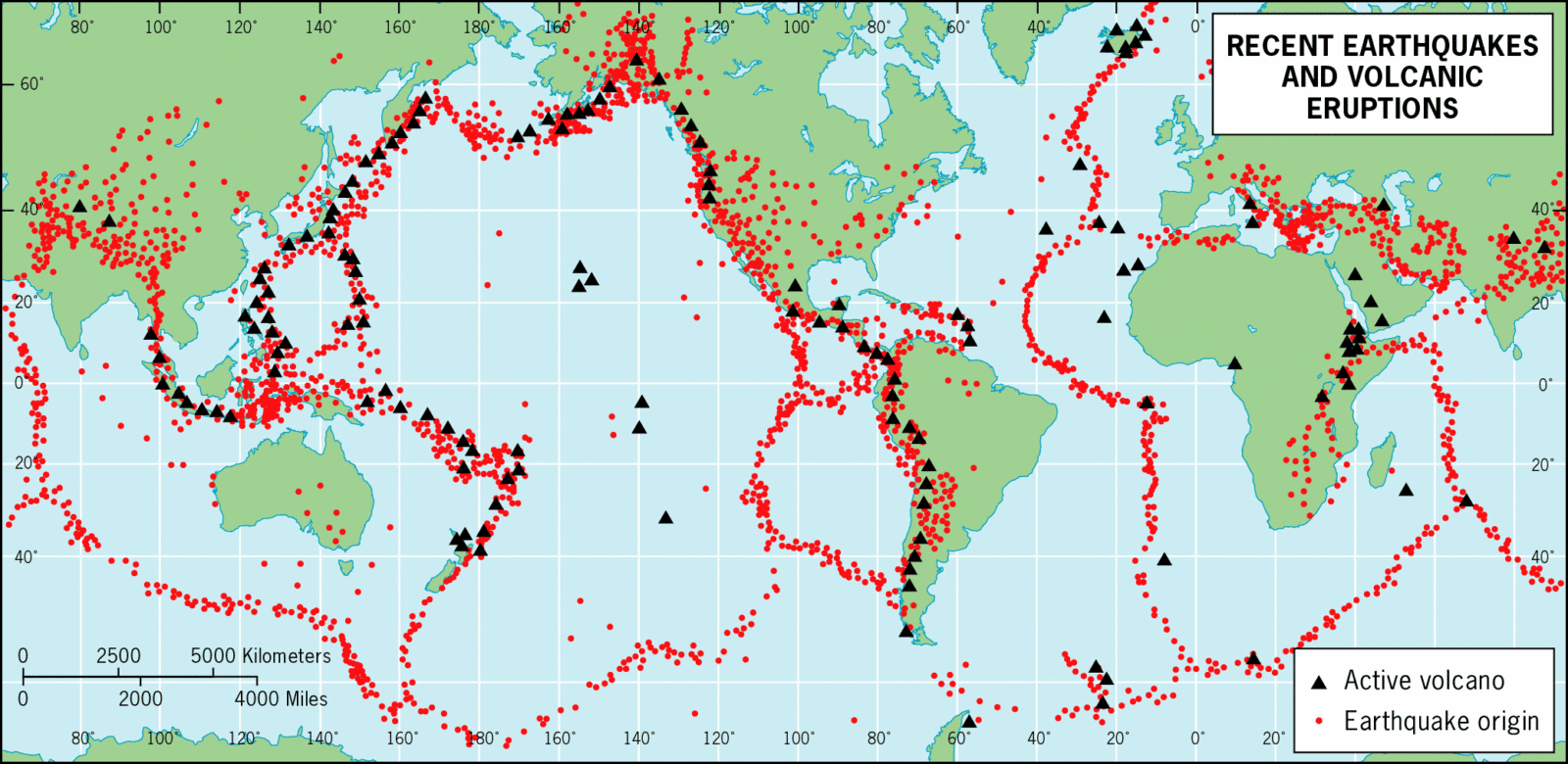
Earthquakes and volcanoes are concentrated along tectonic plate boundaries, as shown in this global map.
-
Magnetic striping on the ocean floor:
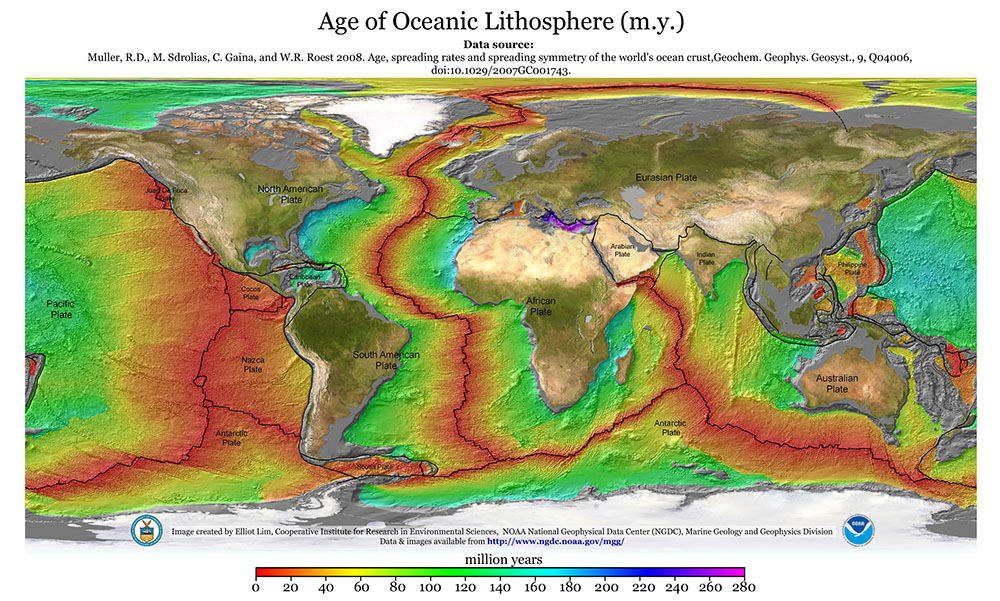
Bands of rock on the seafloor show symmetrical patterns of magnetic reversals, providing evidence for seafloor spreading and plate tectonics.
Image: USGS -
Direct GPS measurement of ongoing plate movement:
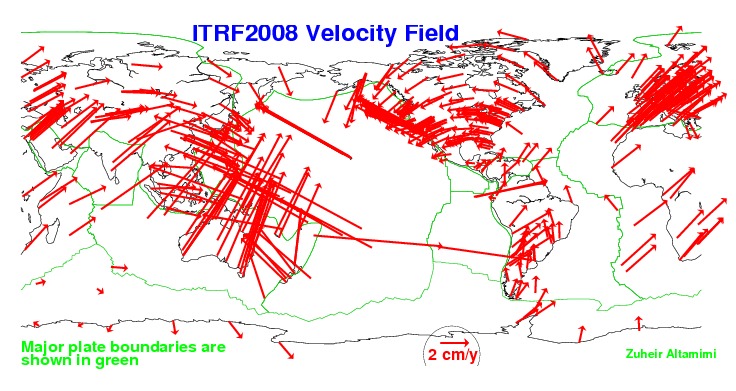
Measured motion of GPS sites. Plate boundaries are shown in green. (Credit: Zuheir Altamimi, ITRF.)
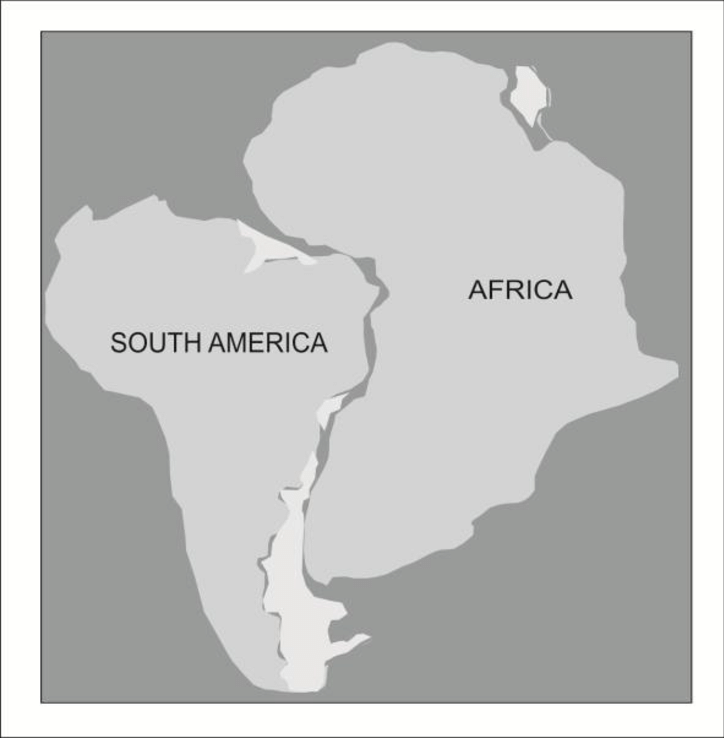
Matching rock formations and fossil types (such as Mesosaurus) are found on both sides of the Atlantic, supporting the idea that these continents were once connected.
Source: Sircar, Anirbid. (2017). GEOLOGY Paper: Sedimentology and Petroleum Geology Module: Plate Tectonic and Global Distribution of Hydrocarbon Reserves.
The Slow Movement Problem
- Current rate: GPS measurements show plates move 1-10 cm per year. At this rate, it takes 100 million years for continents to move apart enough to form Atlantic Ocean.
- Seafloor age gradient: Ocean floor is youngest at mid-ocean ridges and gets progressively older toward the continents, exactly as predicted by gradual seafloor spreading over 200 million years.
- Magnetic reversals: The symmetric magnetic stripes on either side of ocean ridges record hundreds of magnetic field reversals, each taking thousands of years, preserved in rocks formed over millions of years.
- Mountain building: The collision forces needed to build major mountain ranges require sustained pressure over millions of years. The Himalayas are still rising as India continues pushing into Asia.
Fossil Record
The fossil record shows a clear progression of life forms appearing in a consistent sequence worldwide. This pattern is incompatible with all organisms living simultaneously and being buried in a single flood.
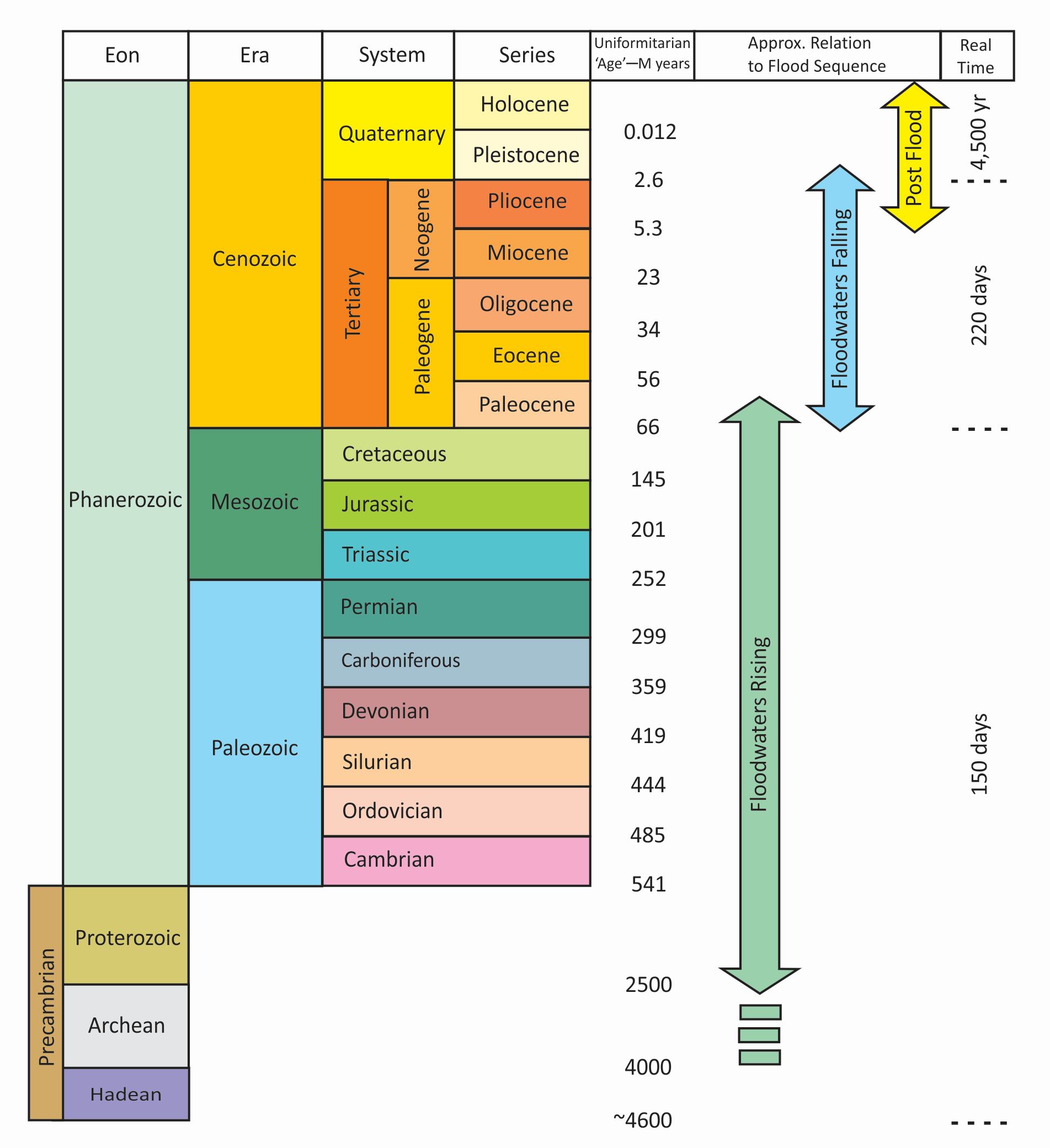
The geologic column with the consensus dates and young earth creationist interpretation shown.
Notice the massive discrepancy between 4.6 billion years and 150 days of geologic time.
Fossil Succession
Different groups of organisms appear, thrive, and often go extinct at specific times in Earth's history, in the same order everywhere on Earth:
-
Precambrian (4.6 billion - 541 million years ago): Only microscopic life, especially stromatolites:
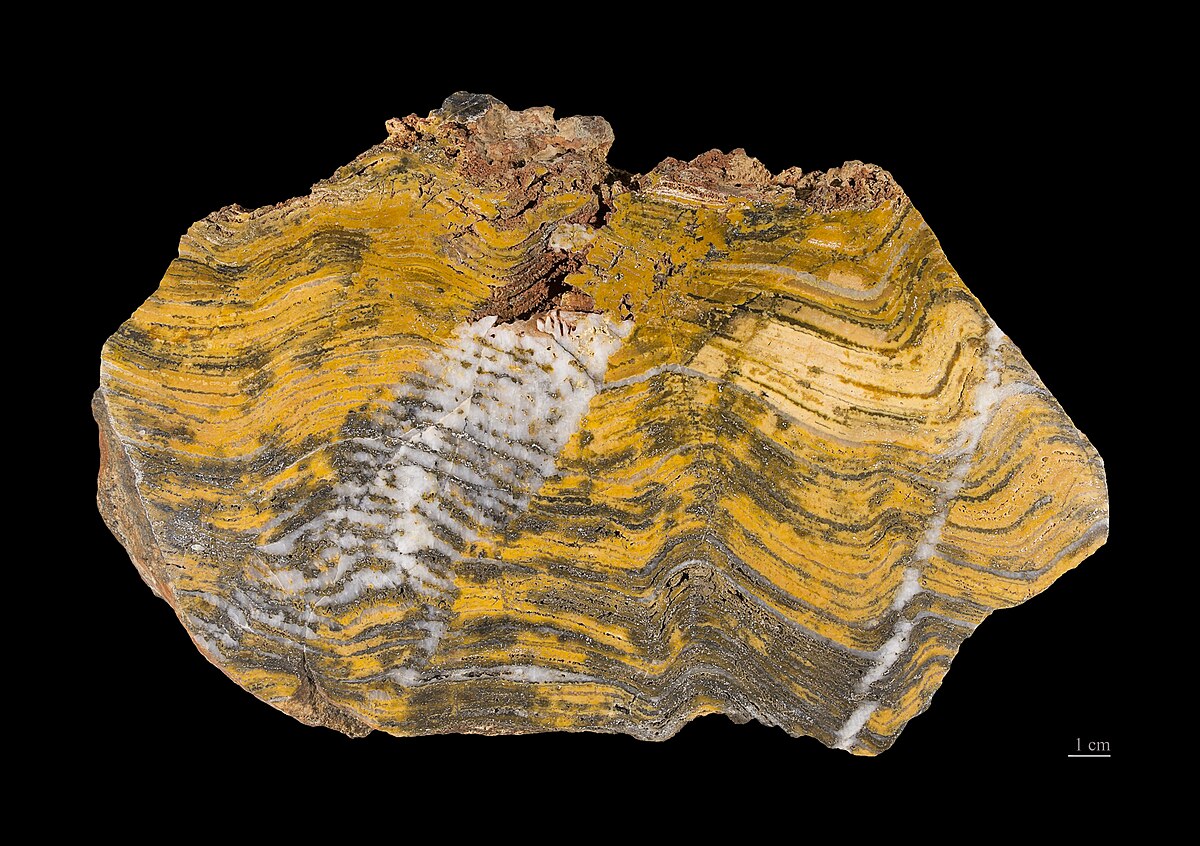
Stromatolite fossil—layered structures built by ancient microbial mats over thousands of years.
-
Cambrian (541-485 million years ago): First abundant complex animals, like trilobites:
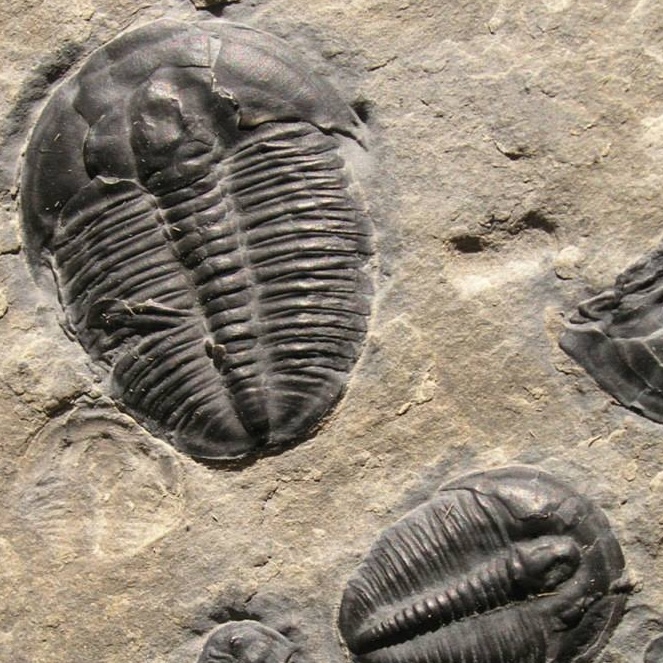
Trilobite fossil (Elrathia kingii), Notch Peak, House Range, Millard County, Utah.
Photographer: Michael Vanden Berg -
Ordovician-Silurian (485-419 million years ago): First fish and early land plants:

Sea scorpion (Eurypterus remipes) from Silurian rocks.
These arthropods were early marine predators. -
Devonian (419-359 million years ago): Age of Fishes, first forests and amphibians:
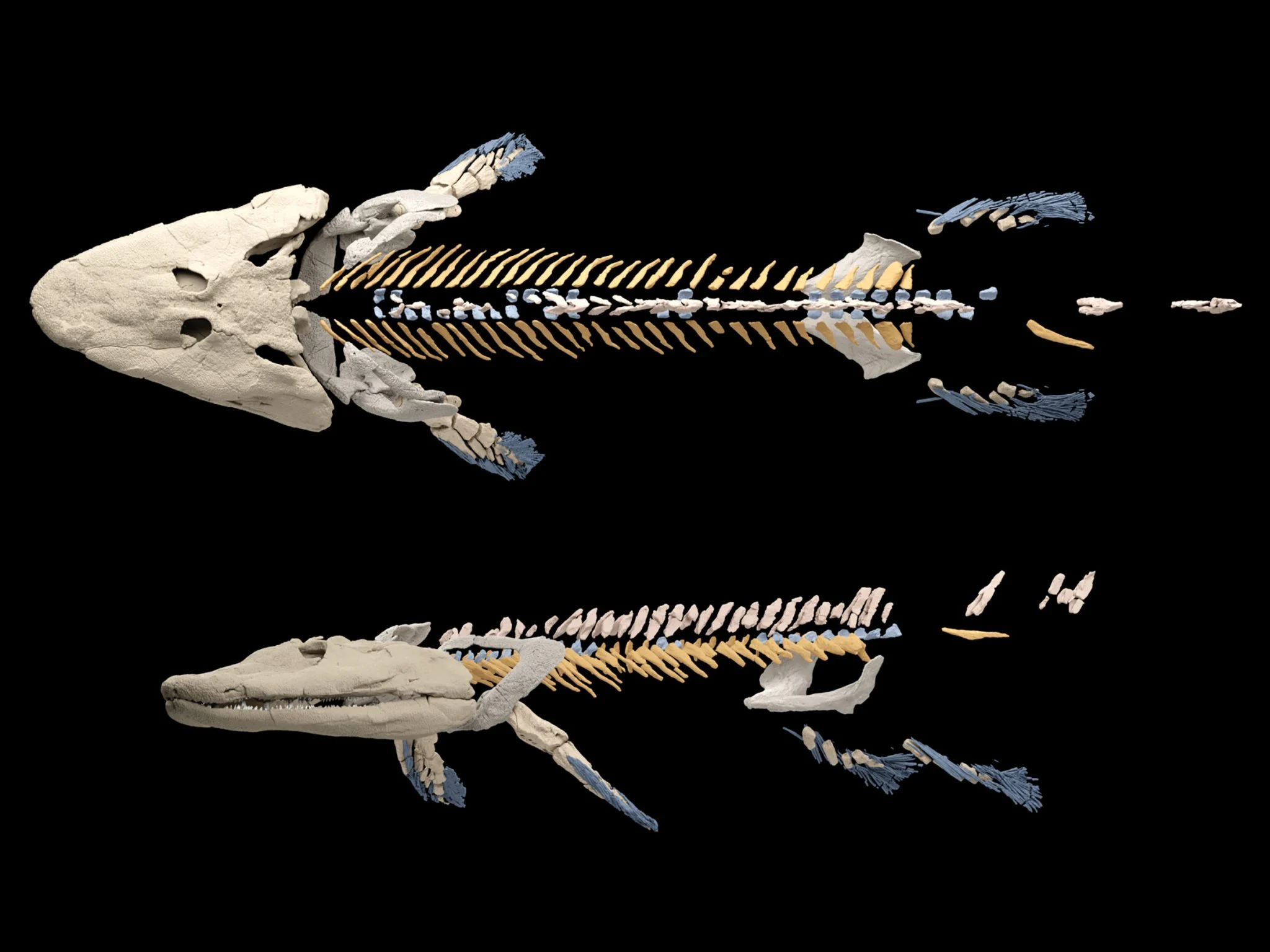
Tiktaalik roseae, a transitional form between fish and early tetrapods.
Credit: Thomas Stewart, Penn State -
Mesozoic (252-66 million years ago): Age of Dinosaurs, no mammals larger than small rodents:
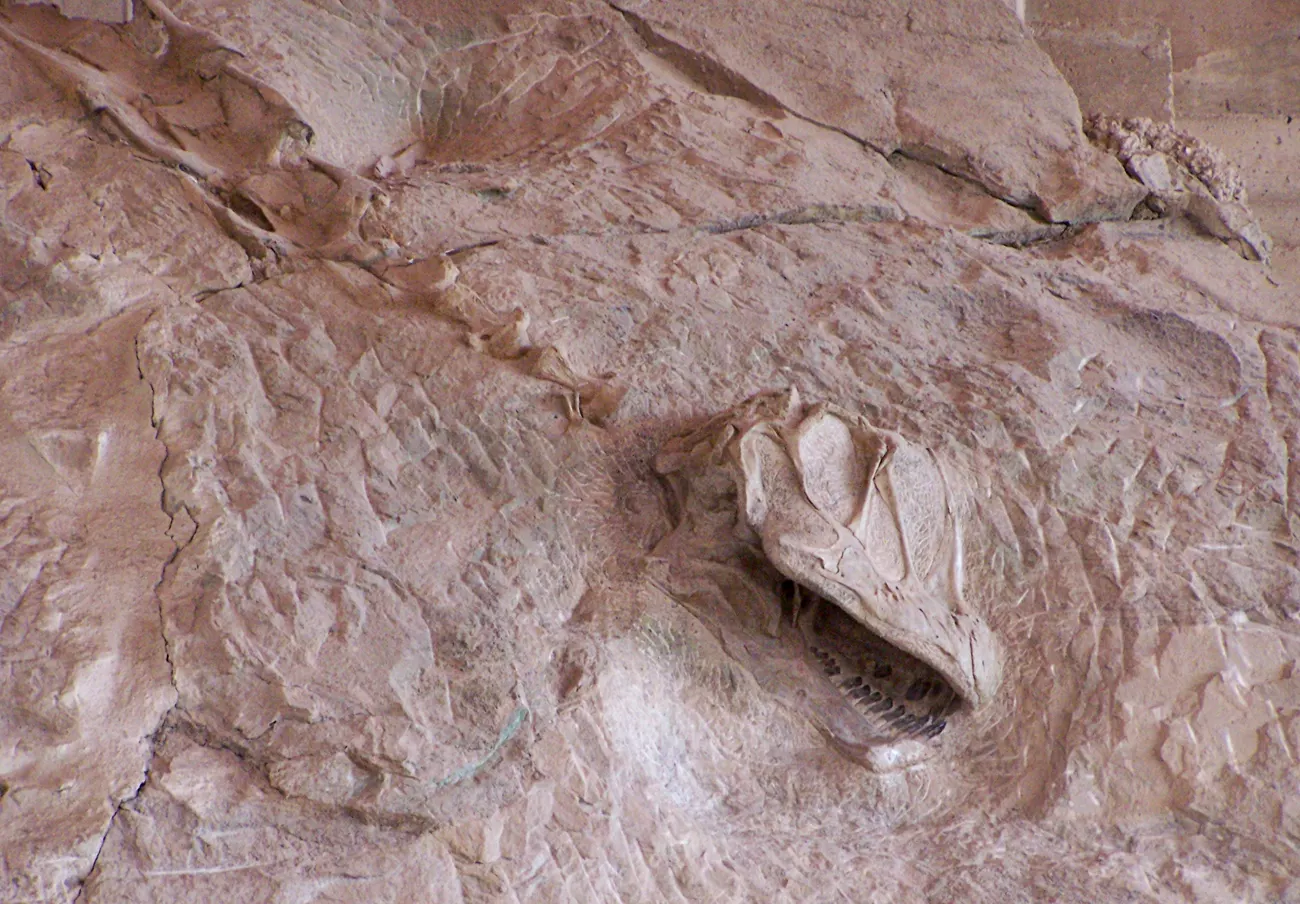
The Mesozoic Era was dominated by dinosaurs. Large mammals are completely absent from these rocks.
-
Cenozoic (66 million years ago-present): Age of Mammals, no non-bird dinosaurs:
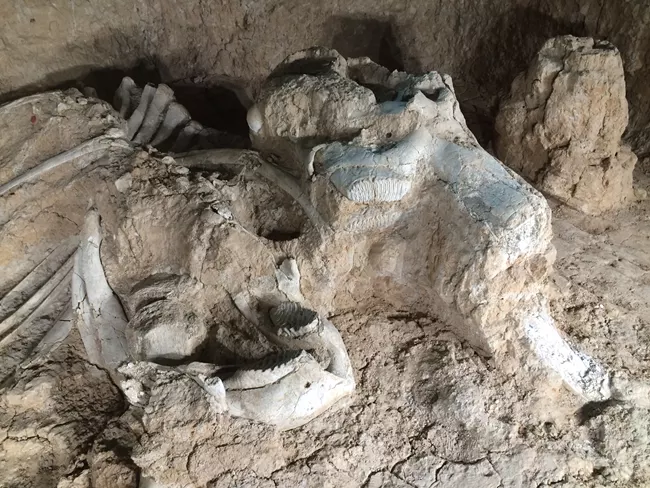
Mammoth fossil at Waco Mammoth National Monument
Credit: City of Waco and Dava Butler
Problems for Flood Geology
- No mixing: If all animals lived together and were sorted by a flood, we would expect some mixing. Instead, the separation is absolute - no rabbits with trilobites, no humans with dinosaurs, no flowering plants in Precambrian rocks.
- Ecological zones don't explain the pattern: Marine and terrestrial organisms show the same temporal sequence, ruling out the idea that different elevations or environments explain fossil order.
- Transitional forms: The fossil record shows gradual transitions between major groups (fish to amphibians, reptiles to mammals, land mammals to whales) in exactly the time periods predicted by evolution.
- Mass extinctions: The fossil record shows several mass extinction events where many species disappear suddenly, followed by the appearance of new species - incompatible with a single flood event.
- Biogeography: Fossils show distinct geographic patterns - marsupials in Australia, unique South American mammals - that match continental drift predictions but make no sense in flood geology.
Age Dating Methods
Multiple independent dating methods all converge on the same ancient ages for Earth's rocks. These methods are based on well-understood physics and chemistry.
Radiometric Dating
Radioactive isotopes decay at precisely known rates, providing reliable clocks for geological time.
Key Radiometric Methods
- Carbon-14: Useful for organic materials up to 50,000 years old. Shows many archaeological sites are older than young-Earth timelines allow.
- Potassium-Argon: Used for volcanic rocks millions to billions of years old. Consistently shows ancient ages for rock layers.
- Uranium-Lead: The most precise method for very old rocks. Individual zircon crystals can be dated to within 1% accuracy.
- Rubidium-Strontium: Used for very old rocks, particularly meteorites and the oldest Earth rocks.
Independent Confirmation
Ages determined by different methods consistently agree:
Convergent Evidence
- Multiple isotope systems: When different radioactive decay systems (like U-Pb, K-Ar, and Rb-Sr) are used on the same rock, they give the same age.
- Meteorite ages: Meteorites consistently date to 4.56 billion years using multiple methods, establishing the age of the solar system.
- Isochron dating: This method is independent of initial isotope concentrations and consistently confirms old ages.
- Concordant ages: When uranium decays to lead through two different pathways, both give the same age for ancient rocks.
Non-Radiometric Dating
Many dating methods don't rely on radioactivity but still show ancient ages:
Additional Time Indicators
- Light travel time: We observe supernovae in distant galaxies whose light has traveled for millions of years to reach us.
- Magnetic field reversals: The pattern of magnetic reversals preserved in rocks spans millions of years and correlates globally.
- Annual layer counting: Ice cores, tree rings, and lake sediments preserve annual layers extending back hundreds of thousands of years.
- Cosmic ray exposure ages: Rocks exposed on planetary surfaces show exposure times of millions of years based on accumulated cosmic ray damage.
Addressing Young-Earth Claims
Common objections to radiometric dating have been thoroughly investigated:
Response to Objections
- "Decay rates could have changed": Changing decay rates would affect nuclear physics, stellar energy production, and leave detectable traces in rocks. No such evidence exists.
- "Initial conditions are unknown": Isochron methods are designed to be independent of initial conditions, yet still give old ages.
- "Contamination affects results": Contamination typically makes samples appear younger, not older. The oldest, least contaminated samples consistently show ancient ages.
- "Only certain results are published": The scientific literature includes many "failed" dates that don't fit expectations, but the overall pattern strongly supports old ages.
Conclusion
The geological evidence presents an overwhelming case for an ancient Earth shaped by gradual processes over billions of years:
Converging Lines of Evidence
- Rock formation processes: Igneous cooling, sediment lithification, and metamorphic changes all require extensive time periods that are incompatible with a young Earth.
- Global stratigraphic consistency: The same sequence of rock layers and fossils appears worldwide with no exceptions, indicating gradual deposition over vast time periods.
- Depositional environments: Preserved desert dunes, coral reefs, glacial deposits, and seasonal layers demonstrate long-term climate patterns and environmental changes.
- Plate tectonics: Continental drift, seafloor spreading, and mountain building require millions of years at observed rates of movement.
- Fossil progression: The orderly appearance and disappearance of life forms through time shows biological change over millions of years, not simultaneous burial in a flood.
- Multiple dating methods: Independent techniques consistently confirm ages of billions of years for Earth's oldest rocks and materials.
Fundamental Problems with Young-Earth Geology
- Time requirements: The physical and chemical processes preserved in rocks require far more time than young-Earth models allow.
- No viable mechanisms: No known natural processes can account for the geological record in thousands rather than millions of years.
- Global consistency: The worldwide uniformity of geological patterns requires coordinated global processes over vast time scales.
- Missing evidence: A global flood should leave distinctive geological signatures that are not found in the rock record.